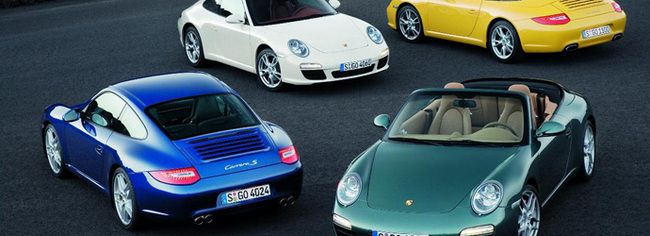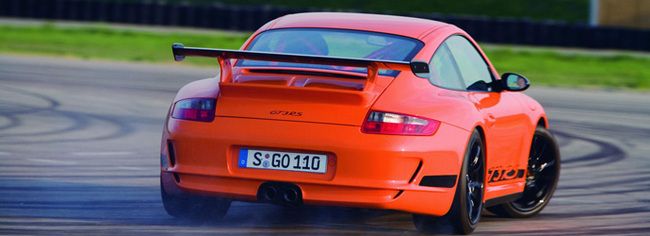Rearview mirror: Porsche 911 (997) - 2004 to 2011
The evergreen 911 will see the launch of the new generation 991 model here really soon. We look back at the seven-year life of the outgoing 997 model.


Over the seven-year lifespan of the 997, Porsche introduced countless variants ranging from mind boggling fast models like the GT2 to limited edition collectors’ models like the Speedster. Here are a few of the most desirable 997 variants out there.

The GT3 was first conceived during the 996 model generation as a sportier and more hardcore model that forms the base for the 911 race cars. The moniker GT3 itself was adopted from the FIA’s GT3 racing formula but race versions of the 996 and 997 went beyond FIA GT3 rules. The Mk 2 997 GT3 offered 435bhp from its race bred 3.8-litre lump and can be easily distinguished from Carrera models by its deep chin spoiler that makes for a great tool to sweep the road ahead, fixed rear spoiler, additional air vents on the front and rear bumpers, lightweight 10-spoke alloys with motorsport inspired centre locking nuts and its lowered stance. The GT3’s motor shares little with the regular Carrera models – its block is shared with the Le Mans 24 hour- winning 911 GT1 from 1998. Aurally, the high revving GT3 motor emits a distinctive, harder edged flat-six roar that sounds markedly different from the Carrera and Turbo models’. For those who want a slightly racier GT3, the model can be specced in Club Sport trim that includes a roll cage adopted from the GT 3 RS.
The GT3 RS is an even more driver focused version of the GT3 – it has more power from the 3.8-litre flat-six (450bhp versus the GT3’s 435bhp in Mk 2 models), has closer gear ratios and lighter. The RS moniker is adopted from the 1973 2.7 RS ‘ducktail’ and stands for ‘Renn Sport’ in German. The RS can be distinguished from the GT3 via its wider wheel arches, racing stripes with colour co-ordinated wheels, unique paint hues, the visible roll cage inside and so on. To further emphasise its hardcore nature, the GT3 RS can be had with a lightweight lithium ion battery, which further saves weight. The GT3 RS is the model used by Porsche to homologate the 911 for racing. The GT3 Cup car used in various Carrera Cup series is based on the GT3 RS.

The GT3 RS 4.0 is the final evolution of the 997. As its name suggests, the GT3 RS 4.0 is a GT3 RS with a 4-litre motor making a whopping 500bhp. The engine not only sees an increase in capacity but also has been strengthened by features like a crankshaft from the RSR race car. Externally, the 4.0 can immediately be recognised by its turning vanes on the corners of the front bumper which are said to improve front downforce, unique racing stripes and an even taller rear wing compared to the GT3 RS’. Those who have driven it has labelled the 4.0 the best 997 variant Porsche ever produced. A production run of just 600 cars probably makes the 4.0 the most desirable of all 997 models. So far, only one 4.0 is known to have been delivered here in Singapore.
The Sport Classic is a limited edition model based on the Carrera S. Inspired by the 1973 2.7 RS, just 250 Sport Classic models were made. The engine had slightly more power than the Carrera S, the wider rear from the Turbo models, lowered suspension, fixed ‘ducktail’ rear spoiler, 19-inch wheels that echo the 2.7 RS’ Fuchs design as well as bespoke grey paint job. The Sport Classic didn’t come cheap though – it was rumoured to cost as much as a Turbo and hence, even local 911 fans couldn’t convince themselves to bag one, but there’s still no denying that the Sport Classic is a stunning looking 997.
Porsche revived the Speedster in 2011, making the 997 Speedster the third 911 Speedster made, the other two being the 930 and 964. Power for the Speedster is courtesy of the Carrera GTS’ lump. The Speedster features a 70mm lower windscreen and the signature ‘humps’ behind the seats. Only 356 997 Speedsters were made, with all painted in either Pure Blue or Carrera White. The production number itself comes from the 356 model from the 50s. A single example in white is known to have been sold to a collector in Singapore.
Just months after Porsche showed the Mk 2 997 Turbo, the more powerful Turbo S was announced. With 530bhp on tap, the S offered 30bhp more than the standard Turbo. The S can accelerate to 100km/h from rest in just over 3 seconds and comes standard with PCCB ceramic brakes and the seven-speed PDK box. In 2011, Porsche introduced the limited edition Turbo S China 10th Anniversary Edition for the Chinese market. The model featured a special gold exterior paint finish, Tequipment aerokit and 19-inch Fuchs wheels – it is limited to only 10 units.
The GT2 RS has the honour of being the most powerful road going 911 model Porsche has ever built. The twin turbocharged flat-six musters 612bhp and 700Nm and together with a 70kg weight saving over the already lairy GT2, will propel the GT2 RS to a terminal velocity of 330km/h. 500 examples of the GT2 RS were made.
Credits: Story by Raymond Lai Photos by Porsche and Raymond Lai


Get the Best Price for your used car
from 500+ dealers in 24 hours

- Convenient and Hassle-Free
- Consumer Protection
Transparent Process
With No Obligation








